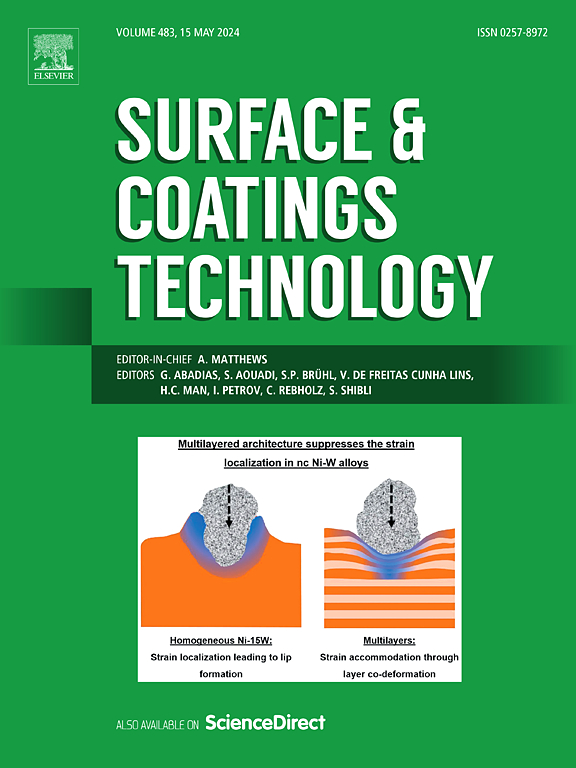Atomic layer deposition of Al2O3 to Ti–6Al–4V feedstock improves powder oxidation resistance and tensile strength in additively manufactured parts
IF 5.3
2区 材料科学
Q1 MATERIALS SCIENCE, COATINGS & FILMS
引用次数: 0
Abstract
With the ever-increasing interest into additive manufacturing (AM) via laser powder bed fusion (PBF-L) of Ti–6Al–4V , there have been numerous efforts to introduce different coatings onto the metal powder feedstock in order to achieve benefits in the PBF-L process. Whether for the purpose of dispersion strengthening, enhanced flowability, or grain refinement, there are several dry coating techniques that can be used to introduce a coating onto the metal powder. In the present investigation, we leverage atomic layer deposition (ALD), a thin-film coating technique, to uniformly coat a continuous layer of AlO onto a batch of Grade 23 Ti–6Al–4V powder. This ALD-coated feedstock was then used in PBF-L to build specimens for analysis of the microstructure and mechanical properties in the as-built and hot isostatic pressing (HIP) treated state. The ALD-coated feedstock displayed greater Hall flowability and oxidation resistance when measured via thermogravimetric analysis in air, with no significant changes to microstructure or bulk morphological features. The microstructure of the as-built and HIPed material stemming from the ALD-coated powder batch was indistinguishable from the material made from virgin powder feedstock, indicating that the ALD AlO layer dissolved into the melt pool and went into solution. The ALD condition had an approximate 80 MPa increase in tensile strength in the as-built condition, and an approximate 70 MPa increase in strength in the HIPed condition due to solid solution strengthening from the increased oxygen content of the ALD coating. The ALD HIPed condition, while somewhat lower in elongation and reduction of area relative to the virgin material after HIP, remained within common material specification requirements for PBF Ti–6Al–4V . While there was an increase in measured oxygen content after the ALD process, this work serves as a proof-of-concept for pre-treating Ti–6Al–4V feedstocks with ALD methodology to achieve benefits in flowability, oxidation resistance, and solid solution strengthening.
在Ti-6Al-4V原料上沉积Al2O3原子层,提高了粉末的抗氧化性和增材制造零件的抗拉强度
随着人们对Ti-6Al-4V的激光粉末床熔融(PBF-L)增材制造(AM)的兴趣不断增加,为了在PBF-L工艺中实现效益,已经有许多努力在金属粉末原料上引入不同的涂层。无论是为了增强分散性,增强流动性,还是细化晶粒,有几种干燥涂层技术可用于在金属粉末上引入涂层。在本研究中,我们利用原子层沉积(ALD),一种薄膜涂层技术,在一批23级Ti-6Al-4V粉末上均匀地涂覆了一层连续的Al2O3。然后在PBF-L中使用这种ald涂层的原料来构建样品,以分析构建状态和热等静压(HIP)处理状态下的微观结构和力学性能。当通过热重分析在空气中测量时,ald涂层的原料显示出更大的霍尔流动性和抗氧化性,而微观结构或整体形态特征没有明显变化。ALD- Al2O3包覆粉末料制备的成品和HIPed材料的微观结构与未加工粉末料制备的材料没有明显区别,表明ALD- Al2O3层溶入熔池并进入溶液。ALD条件下的抗拉强度在原状条件下增加了约80 MPa,而在HIPed条件下,由于ALD涂层中氧含量的增加,固溶体的强度增加了约70 MPa。ALD的HIPed条件,虽然在伸长率和面积收缩率方面相对于HIP后的原始材料有所降低,但仍符合PBF Ti-6Al-4V的通用材料规格要求。虽然ALD处理后测得的氧含量有所增加,但这项工作可以作为用ALD方法预处理Ti-6Al-4V原料的概念验证,以获得流动性、抗氧化性和固溶体强化方面的好处。
本文章由计算机程序翻译,如有差异,请以英文原文为准。
求助全文
约1分钟内获得全文
求助全文
来源期刊

Surface & Coatings Technology
工程技术-材料科学:膜
CiteScore
10.00
自引率
11.10%
发文量
921
审稿时长
19 days
期刊介绍:
Surface and Coatings Technology is an international archival journal publishing scientific papers on significant developments in surface and interface engineering to modify and improve the surface properties of materials for protection in demanding contact conditions or aggressive environments, or for enhanced functional performance. Contributions range from original scientific articles concerned with fundamental and applied aspects of research or direct applications of metallic, inorganic, organic and composite coatings, to invited reviews of current technology in specific areas. Papers submitted to this journal are expected to be in line with the following aspects in processes, and properties/performance:
A. Processes: Physical and chemical vapour deposition techniques, thermal and plasma spraying, surface modification by directed energy techniques such as ion, electron and laser beams, thermo-chemical treatment, wet chemical and electrochemical processes such as plating, sol-gel coating, anodization, plasma electrolytic oxidation, etc., but excluding painting.
B. Properties/performance: friction performance, wear resistance (e.g., abrasion, erosion, fretting, etc), corrosion and oxidation resistance, thermal protection, diffusion resistance, hydrophilicity/hydrophobicity, and properties relevant to smart materials behaviour and enhanced multifunctional performance for environmental, energy and medical applications, but excluding device aspects.
 求助内容:
求助内容: 应助结果提醒方式:
应助结果提醒方式:


